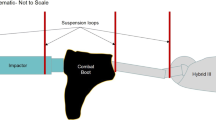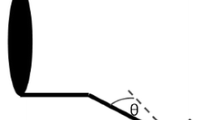Abstract
Incomplete instrumentation and a lack of biofidelity in the extremities of the 6 year-old anthropomorphic test device (ATD) pose challenges when studying regions of the body known to interact with the vehicle interior. This study sought to compare a prototype Hybrid III 6 year-old ATD leg (ATD-LE), with a more biofidelic ankle and tibia load cell, to previously collected child volunteer data and to the current Hybrid III 6 year-old ATD (HIII). Anthropometry, range of motion (ROM), and stiffness measurements were taken, along with a dynamic evaluation of the ATD-LE using knee-bolster airbag (KBA) test scenarios. Anthropometry values were similar in eight of twelve measurements. Total ankle ROM was improved in the ATD-LE with no bumper compared to the HIII. The highest tibia moments and tibia index values were recorded in KBA scenarios when the toes were positioned in contact with the dashboard prior to airbag deployment, forcing the ankle into axial loading and dorsiflexion. While improvements in the biofidelity of the ATD-LE are still necessary, the results of this study are encouraging. Continued advancement of the 6 year-old ATD ankle is necessary to provide a tool to directly study the behavior of the leg during a motor vehicle crash.







Similar content being viewed by others
Abbreviations
- ATD:
-
Anthropomorphic test device
- ATD-LE:
-
Abbreviation for the new prototype Hybrid III 6 year-old ATD leg being evaluated in this study
- BPB:
-
Belt positioning booster
- CRS:
-
Child restraint system
- CVD:
-
Child volunteer data
- DF:
-
Dorsiflexion
- HIII:
-
The abbreviation used for the standard Hybrid III 6 year-old ATD which was used for comparison in this study
- KBA:
-
Knee-bolster airbag
- MVC:
-
Motor vehicle crash
- PF:
-
Plantar flexion
- ROM:
-
Range of motion
References
Arbogast, K. B., J. S. Jermakian, M. J. Kallan, and D. R. Durbin. Effectiveness of belt positioning booster seats: an updated assessment. J. Pediatr. 124(5):1281–1286, 2009.
Bennett, T. D., R. Kaufman, M. Schiff, C. Mock, and L. Quan. Crash analysis of lower extremity injuries in children restrained in forward-facing car seats during front and rear impacts. J. Trauma 61(3):592–597, 2006.
Bing, J., and J. Bolte. Pediatric Lower Extremity: Potential Risks and Testing Concepts. [Master’s thesis]. Columbus: Ohio State University, 2011.
Boucher, L.C., A.M.W. Chaudhari, Y.S. Kang, and J.H. Bolte IV. Range of Motion and Stiffness of the Pediatric Ankle and Implications for Current ATDs. International Research Council on the Biomechanics of Injury Conference, Gothenburg, Sweden. IRC13-28: 195–207, 2013. Conference Proceedings.
Brown, J. K., Y. Jing, S. Wang, and P. F. Ehrlich. Patterns of severe injury in pediatric car crash victims: Crash Injury Research Engineering Network database. J. Pediatr. Surg. 41(2):362–367, 2006.
Bulger, E. M., R. Kaufman, and C. Mock. Childhood crash injury patterns associated with restraint misuse: implications for field triage. Prehosp. Disaster Med. 23(1):9–15, 2008.
Durbin, D. American Academy of Pediatrics Technical Report-Child passenger safety. J. Pediatr. 127(4):e1050–e1066, 2011. doi:10.1542/peds.2011-0215.
Durbin, D., M. Elliott, and F. Winston. Belt-positioning booster seats and reduction in risk of injury among children in vehicle crashes. JAMA 289(21):2835–2840, 2003.
Glass, R. J., M. Segio-Gomez, and J. D. Graham. Child passenger safety: decisions about seating location, airbag exposure, and restraint use. Risk Anal. 20(2):521–527, 2000.
Holbrook, T. L., D. B. Hoyt, R. Coimbra, B. Potenza, M. J. Sise, D. I. Sack, and J. P. Anderson. Trauma in adolescence causes long-term marked deficits in quality of life: adolescent children do not recover preinjury quality of life or function up to two years post injury compared to national norms. J. Trauma 62(3):577–583, 2007.
Hunter, I. W., and R. E. Kearney. Dynamics of human ankle stiffness: variation with mean ankle torque. J. Biomech. 15(10):747–752, 1982.
Ivarsson, B.J., J.R. Crandall, D. Longhitano, and M. Okamoto. Lateral injury criteria for the 6-year-old pedestrian—Part II: Criteria for the upper and lower extremities. SAE International. Paper #2004:01-1755, 2003.
Jermakian, J. S., C. M. Locey, and L. J. Haughey. Lower extremity injuries in children seated in forward facing child restraint systems. Traffic Inj. Prev. 8(2):171–179, 2007.
Johnston, C., F. P. Rivara, and R. Soderberg. Children in car crashes: analysis of data for injury and use of restraints. J. Pediatr. 93(6):960–965, 1994.
Kay, R. M., and C. W. Tang. Pediatric foot fractures: evaluation and treatment. J. Am. Acad. Orthop. Surg. 9:308–319, 2001.
Kearney, R. E., and I. W. Hunter. Dynamics of human ankle stiffness: variation with displacement amplitude. J. Biomech. 15(10):753–756, 1982.
Lapner, P. C., M. McKay, A. Howard, B. Gardner, A. Greman, and M. Letts. Children in crashes: mechanism of injury and restraint systems. Can. J. Surg. 44(6):445–449, 2001.
Leary, J. T., M. Handling, M. Talerico, L. Yong, and J. A. Bowe. Physeal fractures of the distal tibia: predictive factors for premature physeal closure and growth arrest. J. Pediatr. Orthop. 29:356–361, 2009.
Meier, R., C. Krettek, K. Grimme, G. Regel, D. Remmers, P. Harwood, and H. C. Pape. The multiply injured child. Clin. Orthop. Relat. Res. 432:127–131, 2005.
Mertz, H.J. A procedure for normalizing impact response data. SAE. 984:#840884, 1984.
Mertz, H. J., A. L. Irwin, and P. Prasad. Biomechanical and scaling bases for frontal and side impact injury assessment reference values. STAPP Car Crash J. 47:155–188, 2003.
National Highway Traffic Safety Administration (NHTSA). Booster Seat Effectiveness: Estimates Based on CDS and State Data. Washington, DC: U.S. Department of Transportation. DOT HS 811 338, 2010.
National Highway Traffic Safety Administration (NHTSA). Traffic Safety Facts 2012. US Department of Transportation. DOT HS 812 032, 2012.
Norkin, C. C., and D. J. White. Measurement of Joint Motion: A Guide to Goniometry (4th ed.). Philadelphia: F.A. Davis Company, pp. 269–289, 2009.
O’Neil, J., D. M. Daniels, J. L. Talty, and M. J. Bull. Seat belt misuse among children transported in belt-positioning booster seats. Accid. Anal. Prev. 41:425–429, 2009.
Pickrell, T.M., and T.J. Ye. Occupant restraint use in 2011: results from the National Occupant Protection Use Survey Controlled Intersection Study. Washington, DC: National Highway Traffic Safety Administration. DOT HS 811 69, 2013.
Quinones-Hinojosa, A., P. Jun, G. T. Manley, M. M. Knudson, and N. Gupta. Airbag deployment and improperly restrained children: a lethal combination. J. Trauma 59(3):729–733, 2005.
Rhomiller, M. T., T. P. Gaynor, and J. Pawelek. Salter-Harris I and II of the distal tibia: does mechanism of injury relate to premature physeal closure? J. Pediatr. Orthop. 26(3):322–328, 2006.
Ribbans, W. J., R. Natarajan, and S. Alavala. Pediatric foot fractures. Clin. Orthop. Relat. Res. 432:107–115, 2005.
Riemann, B. L., R. G. DeMont, K. Ryu, and S. M. Lephart. The effects of sex, joint angle, and the gastrocnemius muscle on passive ankle joint complex stiffness. J. Athl. Train. 36(4):369–377, 2001.
Snyder R.G., L. W. Schneider, C.L. Owings, et al. Anthropometry of infants, children, and youths to age 18 for product safety design. Highway Safety Research Institute, Ann Arbor, MI. UM-HSRI-77-17, 1977.
Winthrop, A. L., K. J. Brasel, L. Stahovic, J. Paulson, B. Schneeberger, and E. M. Kuhn. Quality of life and functional outcome after pediatric trauma. J. Trauma. 58(3):468–474, 2005.
Zhang, L., L. Chen, A. Vertiz, R. Balci. Survey of front passenger posture usage in passenger vehicles. SAE International. Paper No. 2004-01-0845, 2004.
Acknowledgments
The authors would like acknowledge Doug Longhitano (Honda R&D Americas) and staff for providing the facilities and support for the knee-bolster airbag testing. The authors would also like to thank Mike Carlson (Center for Automotive Research, The Ohio State University) who contributed to the final stiffness bumper design. Additionally, the authors would like to acknowledge the National Science Foundation (NSF) Center for Child Injury Prevention Studies at the Children’s Hospital of Philadelphia (CHOP) and the Ohio State University (OSU) for sponsoring this study and its Industry Advisory Board (IAB) members for their support, valuable input and advice. The views presented are those of the authors and not necessarily the views of CHOP, OSU, the NSF, or the IAB members. This research was supported by the Center for Child Injury Prevention Studies (CChIPS).
Author information
Authors and Affiliations
Corresponding author
Additional information
Associate Editor Joel D. Stitzel oversaw the review of this article.
Rights and permissions
About this article
Cite this article
Boucher, L.C., Bing, J. & Bolte, J.H. Biofidelity Evaluation of a Prototype Hybrid III 6 Year-Old ATD Lower Extremity. Ann Biomed Eng 44, 2794–2804 (2016). https://doi.org/10.1007/s10439-016-1562-1
Received:
Accepted:
Published:
Issue Date:
DOI: https://doi.org/10.1007/s10439-016-1562-1




